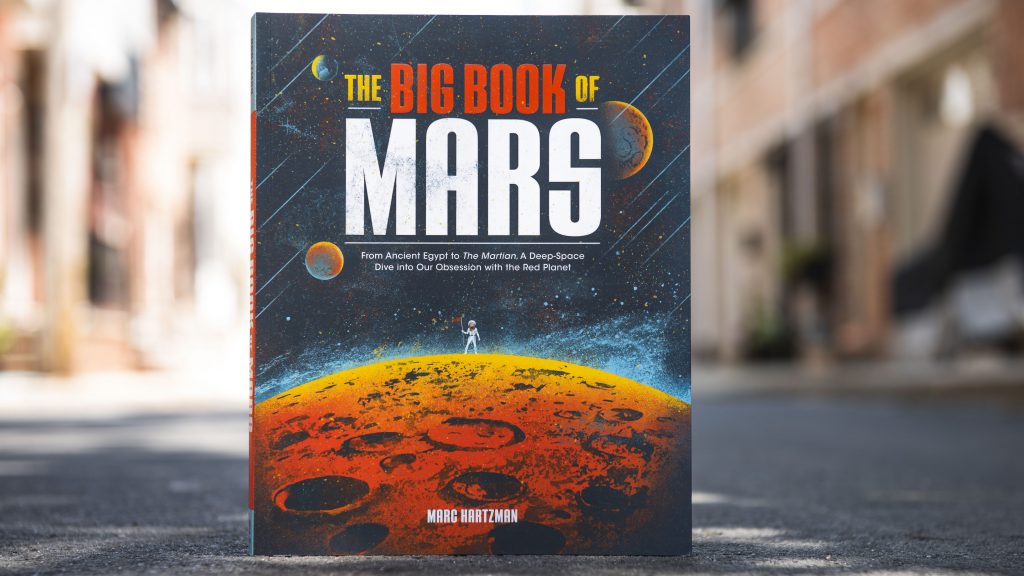Launching All Across Earth: The Big Book of Mars
Science is endlessly fascinating. It’s the puzzle of the universe that great minds have been working on bit by bit since, well, since the first great mind. But this book started with another passion of mine: weird history.
I was researching Nikola Tesla’s attempts to make contact with Mars in the early twentieth century for an article I wanted to write, and stumbled onto another story from the same era. An even better, weirder, and far more wonderful story.
It was the tale of Dr. Hugh Mansfield Robinson—a London lawyer who claimed to be in telepathic communication with a Martian woman named Oomaruru. It sucked me in and got weirder with every newspaper headline I unearthed.
The more I researched it, the more I learned about other Martian beliefs at the time and the greater my obsession became. It all led to this, The Big Book of Mars.
Not only did I find out about Oomaruru (she was quite friendly and had big ears and tall hair) and other attempts to communicate with Martians, but thanks to the many brilliant NASA scientists I spoke with, I learned more than I ever expected to know about planetary science and the past, present, and future of Mars.
It may seem like a cold, dead place, but the Red Planet has many wondrous stories to tell—about itself, and about all of us right here on Earth. I hope you’ll find them as interesting I do. Here’s a little “Fact or Fiction” to get you started.

Fact or Fiction: There are canals on Mars.
Fiction. In 1877, Italian astronomer Giovanni Schiaparelli gazed through his telescope and spotted a network of linear structures on the surface of Mars. He called them “canali,” which means “channels.” But it was mistranslated as “canals.” And canals are artificially made. Such a massive undertaking, it seemed, could only have been accomplished by a race of large, brilliant beings. This inspired the imaginations of science fiction writers and of scientists who desperately wanted to communicate with our superior interplanetary neighbors.
Fact or Fiction: An Amherst professor and director of its observatory once planned to ascend 50,000 feet in a hot air balloon in order to receive messages from Mars.
Fact. During the Mars opposition of 1909, Prof. David Todd believed that reaching such heights in a hot air balloon would allow him to receive signals from Mars without interference. Todd took a test flight and reached 5,000 feet, but never reached his 50,000-foot goal.
Fact or Fiction: Orson Welles’s 1938 broadcast of The War of the Worlds was the only time people believed the story was real and panicked in the streets.
Fiction. You’d think after the national scare the radio show caused people would learn their lesson. But no. Eleven years later a local radio station in Ecuador looking to create some buzz did its own version of the classic H. G. Wells story. Chaos, riots, and death ensued.
Fact or Fiction: Mars might have once supported life.
Fact. Okay, I couched this one with “might.” But numerous discoveries from NASA’s Mars rovers have led scientists to believe Mars was once a warmer, wetter place. That means it would’ve been conducive to supporting life. The Mars Perseverance rover, launching later this month, will land in Jezero Crater—a pit with a delta leading into it, which indicates it was once a lake. Scientists hope it will find signs of ancient life preserved in rocks.
Fact or Fiction: A Satanist helped start NASA JPL.
Fact. Jack Parsons was an occultist and an associate of Aleister Crowley who also led the charge for America’s rocketry program in the 1930s. Along with two friends, the trio of rocketeers got backing from CalTech to play with explosives and explore the boundaries of physics. They were known as the “Suicide Squad.”
Fact or Fiction: Mars is home to the tallest mountain in the solar system.
Fact. Olympus Mons is a sixteen-mile-high mountain that’s as big as Arizona. It’d be perfect for outdoorsy astronauts if it weren’t for all that pesky radiation.
Fact or Fiction: In the 1970s, one of the life detection experiments on the Mars Viking Lander tested positive.
Fact. The experiment, called the Labeled Release experiment tested positive with both Viking 1 and Viking 2. Most people at NASA believe the results can be explained through an exotic chemical reaction vs a biological reaction. But to this day, no theory has absolutely explained the positive results.
Marc Hartzman
Marc Hartzman is “one of America’s leading connoisseurs of the bizarre” (ABCNews.com) and has written books about sideshow performers, Oliver Cromwell’s head, weird things on eBay, and unorthodox messages from God. Hartzman’s work has also appeared in Mental Floss, Bizarre, and HuffPost/AOL Weird News. He’s discussed oddities on CNN, MSNBC, Ripley’s Radio, and the Travel Channel’s Mysteries at the Museum. More of his love for the unusual can be found on his site WeirdHistorian.com. Hartzman works in advertising and lives in New Rochelle with his wife Liz and their two beautiful Earthling girls.



